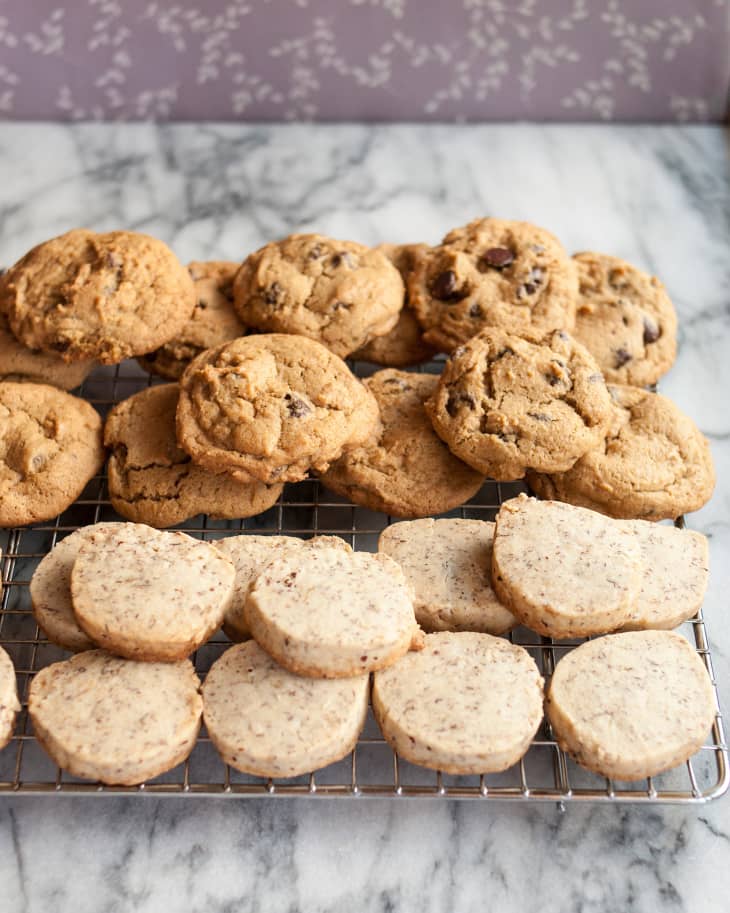8 Things You Need to Know Before Doubling a Cookie Recipe
Have a bake sale or cookie exchange coming up? Before you double your favorite recipe, there are a few things you might want to consider — like the size of your mixer and keeping the extra dough chilled between batches. Let’s get you set up for cookie success.
1. Make sure your mixer will hold a double batch.
You don’t want to get halfway through a recipe and then realize your dough is about to overflow in the bowl. Not only is that annoying, but it can lead to over-mixing as you struggle to work in all the ingredients.
Make a rough estimate of volume by adding up all the main ingredients (flour, sugar, chocolate chips, and so on) and judging that against the capacity of your mixer. If you’re on the fence, it’s best to just make two single batches rather than one big double batch.
2. Know which ingredients can be scaled straight-up.
The main ingredients in a cookie recipe can generally be doubled (or even tripled) without needing to worry or make adjustments. By this, I mean those ingredients that make up the bulk of the recipe, like flour, sugar, water, milk, chocolate, and dried fruit.
Spices can also usually be doubled, but pay closer attention to using the exact amount than you might otherwise — instead of eyeballing your teaspoon, level off the top of the scoop before adding it to the mix. Too much cinnamon or clove in a recipe can turn it into a flavor potpourri.
The only ingredient to really watch out for are the baking powder or baking soda.
3. Do some math before doubling the baking powder or baking soda.
Ninety-nine percent of the time, I find that baking soda and baking powder can be simply doubled in cookie recipes. It’s that last one percent that can sometimes mess up an otherwise awesome batch of cookies. Baking powder and baking soda are tricky and don’t always scale up quite as nicely as everything else. Using too much can mean your cookies will rise impressively, but then collapse and flatten toward the end of cooking or once you pull them from the oven.
To be on the safe side, use the following ratio: For every cup of flour in your recipe, use 1 to 1 1/4 teaspoon of baking powder or 1/4 teaspoon of baking soda. If your recipe uses both baking powder and soda, then try to maintain the ratio of one to the other as best you can.
4. Avoid substitutions when making a big batch.
I’m usually all for playing around with recipes, but this just isn’t the time to experiment with substituting quinoa flour for all-purpose, or honey for the sugar. If you haven’t tried them before, it’s hard to predict how these substitutions will affect the cookies — and you’re about to be making a lot them.
You’re generally fine to substitute supporting ingredients — like chocolate chips for chopped nuts, or cherries for currants — but I recommend avoiding swaps to the core ingredients that can affect the texture or chemistry of the cookie, like the flour, sugar, or eggs.
5. Write down your new recipe.
I’m serious — find a scrap of paper and write down the new ingredient amounts, as fussy as that may sound. I’ve learned this one from experience. There have been far too many times when I think I can get by just doubling ingredients in my head as I go and then forget what I’m doing partway through the recipe.
For recipes that I double frequently, I also write the amounts right there on the page of the cookbook. That way no calculations are required next time I make them.
6. Divide dough in half before rolling.
If you’re making a cut-out cookie or one that require rolling out, like rugelach, divide it in half and work with one piece at a time. Trying to roll out the entire double-batch at once is not only cumbersome, but the dough can start to get too soft and warm, which makes cutting out shapes more difficult.
7. Keep extra dough chilled.
When you’re making a big batch of cookies, that often means cooking several trays back to back in your hot kitchen. Cover and chill your extra dough between batches so the butter doesn’t start melting and the dough doesn’t get too soft, which can affect the texture of the cookie.
8. Cool your baking sheets between batches.
Scooping cookie dough onto a hot baking sheet can make the cookies melt and spread during baking, so remember to cool your baking sheets between batches. If you don’t have extra baking sheets or don’t want to wait for them to cool, try rinsing the baking sheets with cold tap water between batches to cool them down more quickly.
These tips should keep you covered for most batches of cookies. Any other advice to add?
